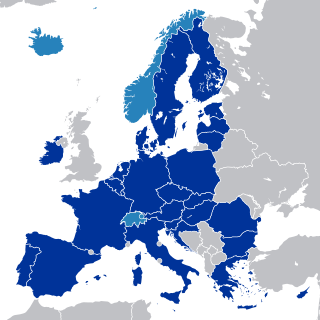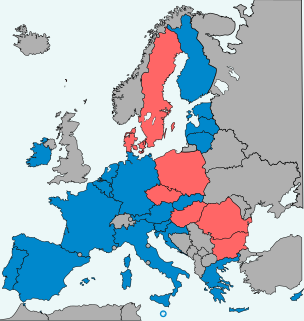Related Research Articles

The European Court of Justice, formally just the Court of Justice, is the supreme court of the European Union in matters of European Union law. As a part of the Court of Justice of the European Union, it is tasked with interpreting EU law and ensuring its uniform application across all EU member states under Article 263 of the Treaty of the Functioning of the European Union (TFEU).

The General Court, informally known as the European General Court (EGC), is a constituent court of the Court of Justice of the European Union. It hears actions taken against the institutions of the European Union by individuals and member states, although certain matters are reserved for the European Court of Justice. Decisions of the General Court can be appealed to the Court of Justice, but only on a point of law. Prior to the coming into force of the Lisbon Treaty on 1 December 2009, it was known as the Court of First Instance.

European Union law is a system of rules operating within the member states of the European Union. Since the founding of the European Coal and Steel Community following World War II, the EU has developed the aim to "promote peace, its values and the well-being of its peoples". The EU has political institutions, social and economic policies, which transcend nation states for the purpose of cooperation and human development. According to its Court of Justice the EU represents "a new legal order of international law".

The European Single Market, Internal Market or Common Market is a single market comprising the 27 member states of the European Union (EU) as well as – with certain exceptions – Iceland, Liechtenstein, and Norway through the Agreement on the European Economic Area, and Switzerland through bilateral treaties. The single market seeks to guarantee the free movement of goods, capital, services, and people, known collectively as the "four freedoms".
Allonby v Accrington & Rossendale College (2004) C-256/01 is a European Union law case concerning the right of men and women to equal pay for work of equal value under Article 141 of the Treaty of the European Community.
Van Duyn v Home Office (1974) C-41/74 was a case of the European Court of Justice concerning the free movement of workers between member states.
A preliminary ruling is a decision of the European Court of Justice (ECJ) on the interpretation of European Union law, given in response to a request from a court or tribunal of a European Union Member State. A preliminary ruling is a final determination of EU law, with no scope for appeal. The ECJ hands down its decision to the referring court, which is then obliged to implement the ruling.

Defrenne v Sabena (1976) Case 43/75 is a foundational European Union law case, concerning direct effect and the European Social Charter in the European Union. It held that the EU:
is not merely an economic union, but is at the same time intended, by common action, to ensure social progress and seek the constant improvement of the living and working conditions of their people...

The Treaty Establishing the European Stability Mechanism was signed by the member states of the eurozone to found the European Stability Mechanism (ESM), an international organisation located in Luxembourg, to act as a permanent source of financial assistance for member states in financial difficulty, with a maximum lending capacity of €500 billion. It replaced two earlier temporary EU funding programmes: the European Financial Stability Facility (EFSF) and the European Financial Stabilisation Mechanism (EFSM). All new bailouts of eurozone member states will be covered by ESM, while the EFSF and EFSM will continue to handle money transfers and program monitoring for bailouts previously approved for Ireland, Portugal and Greece.
Reference for a Preliminary Ruling in the Criminal Proceedings against Bernard Keck and Daniel Mithouard (1993) C-267/91 is an EU law case, concerning the conflict of law between a national legal system and European Union law. The Court found that "selling arrangements" did not constitute a measure having equivalent effect to a quantitative restriction on trade between Member States of the European Community, as it was then. As a result, the 'discrimination test' was introduced to identify such selling arrangements.
Reyners v Belgium (1974) Case 2/74 is an EU law case, concerning the free movement of services in the European Union.
Opinion 2/13 (2014) is an EU law case determined by the European Court of Justice, concerning the accession of the European Union to the European Convention on Human Rights, and more generally the relationship between the European Court of Justice and European Court of Human Rights.
Inuit Tapiriit Kanatami v Parliament and Council (2013) C-583/11 is an EU law case, concerning judicial review in the European Union.
Miles v European Schools (2011) C-196/09 is an EU law case, concerning preliminary references to the Court of Justice of the European Union.
Srl CILFIT v Ministry of Health (1982) Case 283/81 is an EU law case, concerning preliminary references to the Court of Justice of the European Union.
Outright Monetary Transactions case (2014) BVerfGE 134, 366 is an EU law case, concerning preliminary references to the Court of Justice of the European Union.
Société anonyme Cimenteries CBR Cementsbedrijven NV v Commission (1967) Case 8/66 is an EU law case, concerning judicial review in the European Union.

R (Watts) v Bedford Primary Care Trust (2006) C-372/04 is a UK enterprise law case, concerning health care in the UK.
United Brands v Commission (1976) Case 27/76 is an EU competition legal case concerning abuse of a dominant position in a relevant product market. The case involved the infamous "green banana clause". It is one of the most famous cases in European competition law, which seeks to ban cartels, collusion and other anti-competitive practices, and to ban abuse of dominant market positions.

Ker-Optika bt v ÀNTSZ Dél-dunántúli Regionális Intézete [2010] ECR, Case C-108/09 is an EU law case concerning a conflict of law between Hungarian national legislation and European Union law. The Hungarian legislation regarding the online sale of contact lenses was considered with regards to whether it was necessary for the protection of public health, and it was concluded that this could have been done by less restrictive measures. Despite the internal measure in this case being categorised as a selling arrangement, which would generally be determined by the discrimination test established in Keck, the Court went on to use a market access test, as per Italian Trailers. Thus, this case is crucial in the recent development of the tests for determining measures equaling equivalent effect.